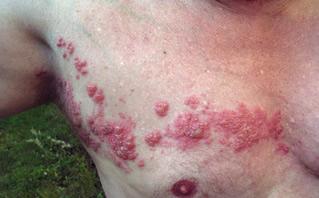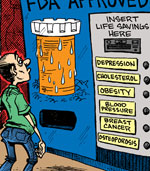What Causes Shingles Disease?
| Share on Facebook | Share on Twitter | Share on Google+ |
Typically, shingles only appear on one side of the body, and only on a very limited part of that one side of the body. Before the 1800's, this peculiar presentation made shingles seem to be very mysterious disease. Then anatomists learned that the nerves that detect sensations in the skin are laid out in symmetrical pairs on opposite sides of the body, and doctors noticed that shingles occur only in the region of skin served by a specific nerve.
Each of the nerves registering sensations in the skin branches out of the spine to a specific dermatome, a specific "slice" of the skin served by that nerve. The nerve carries sensations from the skin to the spine, and nerves in the spinal cord convey those sensations to the brain. Shingles usually occurs just in a single dermatome, or even just part of a dermatome, or perhaps in two or three adjacent dermatomes. Shingles almost never covers the entire body.
Shingles differs from other skin conditions in that the pain of shingles originates in the nerve itself, not in the skin. There are no irritating substances that come in contact with the skin or that are made by the skin. All the irritation and inflammation originates in the nerve and comes to the surface to cause additional irritation and inflammation where it can be seen.
Even after the skin has healed, nerve pain can continue. Shingles may be followed by herpetic neuralgia, which can cause intense pain weeks, months, and years after the skin has healed. Shingles on the face may cause Bell's palsy, which leaves one side of the face partially paralyzed with uncontrollable drooling, crying, or uncontrollable expressions that do not express the inner emotional state.
Why Does the Varicella-Zoster Virus Cause Shingles?

Shingles Appears on One Side of the Body
Photo by Fisle
The varicella-zoster virus never really goes away after chicken pox. It retreats to the dorsal ganglia of nerve cells underneath the skin. The dorsal ganglia are knots at the end of the nerve closest to the spine. A nerve is a single cell. Its DNA is in the dorsal ganglia, and it is in the DNA that the virus attaches itself.Eventually something wakes up the virus and it begins to replicate itself. It travels out along the long, fluid-filled axon of the nerve. As it travels through the axon, it releases chemicals that cause the sensation of heat and pain. At the end of the nerve nearest the skin, the nerve branches into dendrites, which look like the branches of a tree. At the dendrites, the virus leaves the nerve and infects the skin, but this is only at the very end of the process of infection.
What Wakes Up the Shingles Virus?
When you get shingles, your body eventually defeats the infection with the help of white blood cells known as T-cells. Some T-cells cause inflammation that destroys the virus in the skin, and the skin along with it, causing the characteristic painful sores of chicken pox. Some T-cells keep the process of inflammation in check, so that all of your skin is not destroyed in the attempt to kill the localized pockets of infection with the virus.
As you recover from chicken pox, the T-cells go to the thymus gland, where successive generations of T-cells are "taught" how to recognize the virus. Your immune system defeats the virus everywhere except in the dorsal ganglia of the nerves, but for a very long time it is able to stop the virus from spreading out of its hiding place. That is, the immune system is able to keep the virus in check as long as the the majority of T-cells don't "forget" how to recognize it. This can happen with age, but it can also happen with compromise to the immune system.
When Does the Immune System "Forget" How to Fight Shingles?
At one time, nearly everyone caught chickenpox at one time or another during childhood. Of people who once had chickenpox, from 10 to 20% will develop shingles at some time during the remainder of their lives.
Shingles are especially common in people who:
- Undergo chemotherapy to fight cancer,
- Develop lymphoma or kidney cancer,
- Take anti-rejection drugs after a transplant,
- Become infected with HIV,
- Receive bone marrow transplants, or
- Suffer severe stress or exhaustion.
Because severe stress is hard to measure, doctors tend to discount it as a cause of shingles. In the slightly modified real-world examples of shingles mentioned at the beginning of this article, Jon developed shingles after he returned to his position at one of the brokerage houses wiped out in the stock market crash of 2008. Lisa developed an itchy nose and then full-blown shingles while she was rehearsing for her school play. Pat came down with shingles as she was contemplating having to close her business rather than pass it down to her daughter.
Up to 50% of adults who develop compromised immune systems will develop shingles. Age is also a factor in the risk of shingles. By the age of 85, nearly 50% of people who had chickenpox during childhood will have an outbreak of shingles. Blacks, however, have a much lower risk of shingles than Whites.
What Does Shingles Feel Like?
Shingles usually has a prodrome of two to three weeks. While the virus is traveling up the nerve to the skin, there can be a variety of sensations of not feeling quite right. There can be fever, nausea, heartburn, flu-like muscle pain, or just a "creepy-crawly" feeling in the skin. Just before shingles breaks out on the skin, there can be intense burning and stabbing pain that some people mistake for migraine or a heart attack.
When the skin blisters, there is no doubt you have shingles. The pustules break open and scab over, but itching and pain continue until the skin is healed, and sometimes even after the skin is healed. The stabbing and burning pain of shingles can continue indefinitely, especially if the virus emerged from the trigeminal nerve in the face.
-
Skin CareMen Skin Care
-
Free ResourcesFree eBooks
-
The way you think, the way you behave, the way you eat, can influence your life by 30 to 50 years.Deepak Chopra
-
What We RecommendIf you do an analysis of the ingredients in a bottle of
 Total Balance and compare with other products you will find that it provides exceptional value for money…even against simple mass produced products with lower bottle costs.
Total Balance and compare with other products you will find that it provides exceptional value for money…even against simple mass produced products with lower bottle costs.
-



















